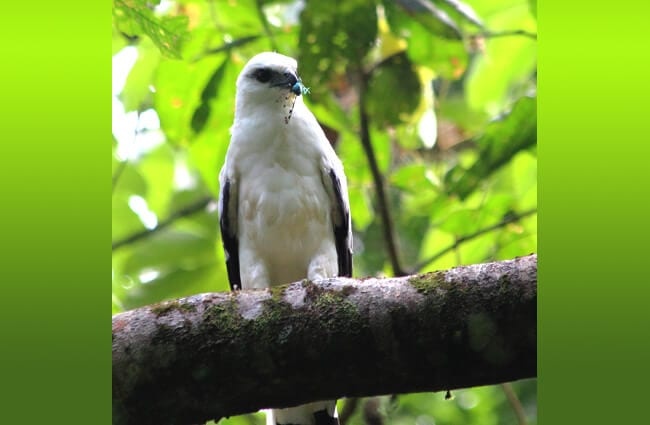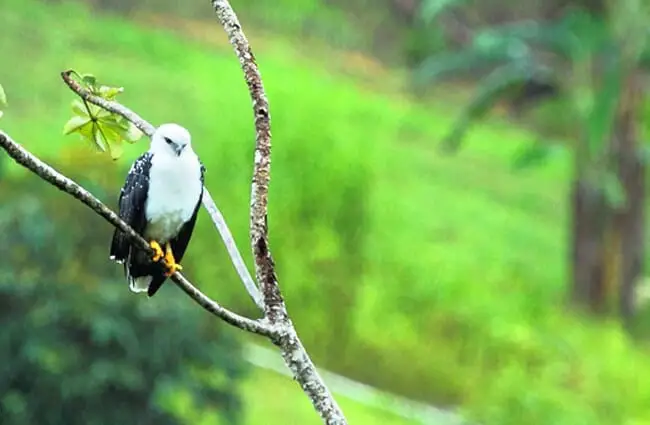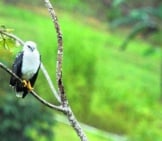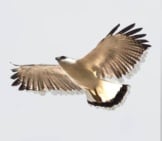The White Hawk is a Central and South American bird of prey with predominantly white plumage, or feathers. It is closely related to two other South American hawk species, the mantled hawk, and the grey-backed hawk.
This is one of the few hawk species with mostly white feathers. However, they are not the only white bird of prey, as the snowy owl is primarily white and grey as well. Read on to learn about the White Hawk.
Description of the White Hawk
These hawks have long wings and short tails. Across different regions, different subspecies of Whites vary slightly in appearance. Each of the four subspecies looks slightly different. They are mostly white, with black coloration on the tips of their wings, and a black bar across their tail.
Some subspecies also have black markings on their heads. All subspecies are similar in size, with most birds weighing about one and a half or two pounds.
Interesting Facts About the White Hawk
These beautiful hawks live across much of Central and South America. While they are common and widespread, there is a lot to learn about this bird and its behavior! Learn more about White Hawks below.
- Four Subspecies – There are four different subspecies of these hawks across their wide range. These subspecies do not have common names, but do live in different regions. The four subspecies are, Pseudastur albicollis albicollis, a. williaminae, P. a. costaricensis, and P. a. ghiesbreghti.
- Cooperation – These hawks like to follow coatis and capuchin monkeys. Not to eat them, but to eat the prey that they scare into the open. These hawks like to eat a variety of insects, lizards, snakes, and other small creatures.
- Rainforest Research – Scientists have a lot to learn about this hawk species. Even though these birds are widespread and relatively common, research on their behavior and breeding habits is lacking. Researchers still do not know very much about this bird’s breeding habits, predators, or territory.
Habitat of the White Hawk
This hawk species lives primarily in forest habitats. They remain in lowland forest rather than expanding into higher elevations like mountains. Despite this, researchers spot these birds more frequently in areas with hills, rather than flat areas. They live in a variety of forest types, including rainforest, evergreen, and more.
Distribution of the White Hawk
These hawks live from southern Mexico all the way to Brazil and Bolivia. Populations of White Hawks live in throughout portions of Central America, primarily along the coast of the Caribbean Sea.
In South America, they live throughout the Amazon River Basin, in Brazil, Guyana, French Guyana, and Suriname. Parts of their populations also extend into Venezuela, Columbia, Peru, and Bolivia.
Diet of the White Hawk
Like all birds of prey, White Hawks are carnivores, and eat mostly meat. These hawks hunt smaller prey items like insects, reptiles, and small mammals. Some of their most common meals include snakes, lizards, frogs, locusts, mice, centipedes, spiders, and more.
They also eat small birds like tinamous, wrens, and toucans. The hawks hunt prey by standing quietly on perches and waiting for prey to stray too close.
White Hawk and Human Interaction
White Hawks have strong population numbers, but they are decreasing across their range. The IUCN lists this species as Least Concern, but acknowledges that there are threats to their survival.
Deforestation in the Amazon River Basin is rampant and destructive. Researchers believe that these birds could lose as much as a quarter of their current habitat in the next two decades.
Domestication
Humans have not domesticated this hawk species in any way.
Does the White Hawk Make a Good Pet
No, these hawks do not make good pets. They are wild birds, and not friendly towards humans. In most places, it is illegal to own one as a pet.
White Hawk Care
These birds are not very common in zoos. Those in zoos would have similar care requirements to other birds of prey. They would need plenty of opportunity to fly and stretch their wings, and a variety of foods. Zookeepers would likely feed them rats, mice, chicks, and even fish.
They would also likely train the birds to stand on gloves, so that they could participate in talks and presentations to the public. These presentations help educate the public about the dangers of deforestation and other important environmental concerns.
Behavior of the White Hawk
Researchers know very little about this species and its behavior. Like most birds of prey, they are solitary and active during the day, or diurnal.
Sightings commonly report that this species soars over the top of the forest canopy, but this is not their primary hunting behavior. While hunting, they stand on tall perches, usually near clearings or the edges of the forest.
Reproduction of the White Hawk
Breeding seasons vary based on the region and subspecies. Pairs build their nests in trees, usually out of sticks and branches. They lay a single egg, and incubation lasts about a month. It takes about three months for the chicks to begin learning how to fly.
Scientists believe that the chicks remain dependent on their parents until the following breeding season. Pairs only breed once every two years, likely to enable them to assist in the care of their yearling young.









![Red Angus Closeup of a beautiful Red Angus cowPhoto by: U.S. Department of Agriculture [pubic domain]https://creativecommons.org/licenses/by/2.0/](https://animals.net/wp-content/uploads/2020/03/Red-Angus-4-238x178.jpg)












![Red Angus Closeup of a beautiful Red Angus cowPhoto by: U.S. Department of Agriculture [pubic domain]https://creativecommons.org/licenses/by/2.0/](https://animals.net/wp-content/uploads/2020/03/Red-Angus-4-100x75.jpg)

